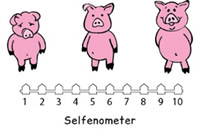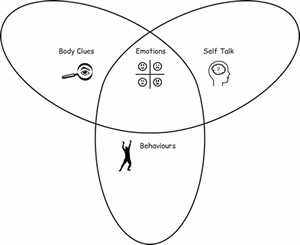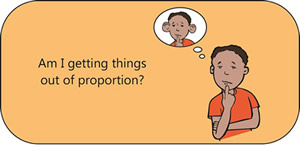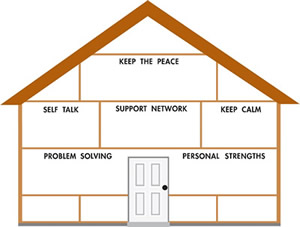RAP-A - For Adolescents
RAP-A was developed to meet the need for a universal resilience building program for teenagers which could be readily implemented in a school setting. A universal program targets all teenagers in a particular grade as opposed to those at higher risk for depression (indicated or selective approaches) or a treatment group. It is easier to recruit and engage adolescents in a universal approach where students do not face the risk of stigmatisation by being singled out for intervention. The Resourceful Adolescent Program (RAP: Shochet, Holland & Whitefield, 1997) was developed to meet this need.
RAP-A is a positively focused program that consists of 11 sessions of approximately 50 minutes duration. The program is run with groups of adolescents varying in size from 8 to 16 students, usually as an integral part of the school curriculum (from grades 7 to 10). RAP-A attempts to integrate both cognitive-behavioural and interpersonal approaches to improve coping skills and build resilience to promote positive development.
Program content
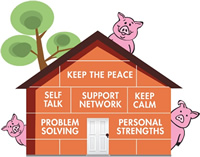 The RAP-A Program draws on the metaphor in the children's story of the "Three Little Pigs" in which only the house made of bricks withstood the attacks of the Big Bad Wolf. Each week participating adolescents develop their own personal 'RAP-A house' by laying down different personal resource bricks (e.g. 'Personal Strength Bricks', 'Keeping Calm Bricks', 'Problem Solving Bricks'), as the program unfolds.
The RAP-A Program draws on the metaphor in the children's story of the "Three Little Pigs" in which only the house made of bricks withstood the attacks of the Big Bad Wolf. Each week participating adolescents develop their own personal 'RAP-A house' by laying down different personal resource bricks (e.g. 'Personal Strength Bricks', 'Keeping Calm Bricks', 'Problem Solving Bricks'), as the program unfolds.
The cognitive-behavioural component provides the techniques of keeping calm, cognitive restructuring and problem solving. The interpersonal component stresses the importance of promoting harmony and dealing with conflict and role disputes by developing an understanding of the perspective of others. The common thread that runs through the program is the teaching of techniques to maintain self-esteem in the face of a variety of stressors.
In the traditional RAP-A there are eleven group sessions, conducted weekly for between 40 and 50 minutes during school class time, with one facilitator per group. However, some collapsing of sessions if longer periods of time are available is possible (for example, six sessions of one and a half hours). Sessions are focussed around seven major areas:
- the recognition and affirmation of existing strengths and resources
- promoting self-management and self-regulation skills in the face of stress
- cognitive restructuring
- creating a personal problem solving model
- building and accessing psychological support networks
- considering the other's perspective
- keeping and making the peace
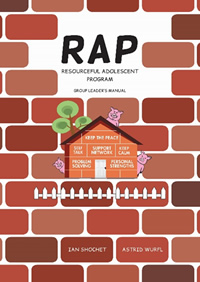 The content and process of each session of the program is specified in a Group Leader's Manual - 2nd Edition (Shochet & Wurfl, 2015). Participant workbooks - 2nd Edition (Shochet & Wurfl, 2015) are provided to each student in the program.
The content and process of each session of the program is specified in a Group Leader's Manual - 2nd Edition (Shochet & Wurfl, 2015). Participant workbooks - 2nd Edition (Shochet & Wurfl, 2015) are provided to each student in the program.
Click here to see a table showing the titles and main aims of each of the sessions in the RAP-A Program.
Research
Careful evaluation, including controlled trials, has shown RAP-A to be a successful preventive intervention for adolescent depression. For summaries of some of the major trials please see Research. For copies of reprints of publications, please email rap@qut.edu.au.
Implementing the program
Selecting group leaders
Who is eligible?
The role of group leader is critical to the effectiveness of the RAP program. Group leaders need to be educational or mental health workers with specific training in the facilitation of RAP-A groups. The following people may be suitable for facilitating the RAP-A program.
- Psychologists/ Social workers / Occupational therapists / Psychiatrists / Mental Health Nurses
- School counsellors/ Guidance officers/Chaplains
- Teachers
- Community workers
Training events are offered at regular intervals in Brisbane and Sydney, and throughout Australia on request. Individual or small group Skype training is available for overeas consumers. See Training for details of upcoming courses.
The RAP team travels to alternative locations to provide training. To date, the team has travelled to all Australian states and territories, as well as to New Zealand, South Africa, Korea, the U.S.A. and parts of Europe to provide training. See Training for information on how to access training
Group participants and size
The RAP program has been designed for adolescents aged 12-16.
Small group sizes (up to 15 participants) are optimal when implementing the RAP program. This helps students to form good connections with other group members and the adult facilitator. It is the belief of the RAP researchers that the small groups contribute a great deal to the success of the RAP Program.
RAP-A resources
RAP-A Group Leader's Manual
This 139-page manual has been designed to provide detailed information about the content of each of the eleven sessions. In addition, the manual describes each of the activities used to demonstrate the concepts being introduced throughout RAP-A. Each session begins by outlining the resource requirements, and ends with a copy of the hand-outs. Found in the Participant Workbook.
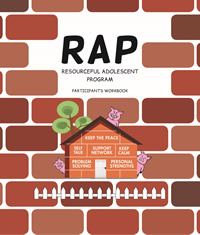 RAP-A Participant's Workbook
RAP-A Participant's Workbook
The RAP-A Workbook comprises all of the activities and information required for the program's individual and group activities. A Participant Workbook is required for each adolescent to write in, and keep at the end of the program. (75 pages)
Supplementary DVD
With the purchase of a RAP-A or RAP-P Group Leader Manual, a Supplementary DVD is provided. This DVD provides supplementary material to be used in activities throughout the programs.
RAP-A Indigenous Supplement The RAP-A Indigenous supplement has been designed to provide guidelines for the Adaptation and implementation of the RAP Program for indigenous adolescents. It describes a variety of adaptations that have been made to RAP-A to make it more suitable for indigenous teenagers.
Sessions, key messages and aims in the Resourceful Adolescent Program (RAP-A)
Session | Key Message | Goals | |
| 1. | Getting to know you | We're interested in you! Let's work together as a team. | Establish rapport and build trust between group members and group facilitator. |
| 2. | Building self-esteem | I'm OK. I'm building on my strengths. | Introduction to program elements and concepts of self-esteem and personal strengths explored. |
| 3. | Introduction to the RAP model | Our body clues and our self-talk affect the way we feel and behave. | Links between behaviour, body clues, self-talk and emotions are explored, concepts of ‘risky’ and ‘resourceful’ responses are introduced. |
| 4. | Keeping calm | Be a detective. Find your body clues and keep calm | Detailed exploration of body signals related to positive and negative feelings, strategies to relax and manage stress and anger are explored. |
| 5. | Self-talk | I am what I think. | Exploration of how thoughts affect feelings and behaviour; the skills of cognitive restructuring. |
| 6. | Thinking resourcefully | You can change your thinking. | Continues session 5 with a focus on challenging risky negative thoughts and promoting positive self-talk. |
| 7. | Finding solutions to problems | There are solutions to my problems. | Outlining of a problem solving model and applying it to interpersonal situations. |
| 8. | Identifying and accessing support networks | There is always help at hand. | Identification and development of a social support network for good times and bad times. |
| 9. | Considering the other person's perspective | There are two sides to every story. Take time out, stop and think. | Developing skills to identify the body clues, self-talk and emotions that the other person might be experiencing in interpersonal situations. |
| 10. | Keeping the peace and making the peace | Keep the peace and make the peace. | Strategies to prevent or manage conflict or to move on from conflict situations. |
| 11. | Putting it all together | Being a resourceful adolescent really works! Let's celebrate. | Review of program content, termination and celebration. |
 Resourceful Adolescent Program
Resourceful Adolescent Program